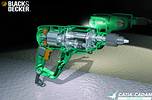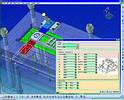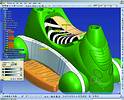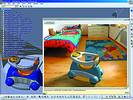Styled plastic products and packaging - main pains and solution initiatives
June 2004
Ulrich Sendler – independent IT consultant and journalist. White paper supplied by IBM.

In today’s highly competitive market for styled plastic products and packaging, the operative words are ‘flexibility’ and ‘innovation’. Customers want both, and the ability to deliver them marks the dividing line between companies that are gaining market share and those that are losing it. Unfortunately, most companies focus only on issues that enter the equation too late – after the bid is won or lost. To win today, flexibility and innovation must be apparent to the prospect or customer from the first sales meeting.

In brief
Competition in virtually every segment of business is tough and getting tougher, and the environment for companies in the segment of styled plastic products and packaging is no exception:
* The market demands mass customisation - tremendous product variety and flexibility under conditions of mass production.
* Environmental standards are changing quickly.
* Product lifecycles are continuously shrinking.
* Environmental standards are changing quickly.
* Product lifecycles are continuously shrinking.
At the same time, however, customer expectations continue to escalate, including requirements that manufacturers:
* Translate customer wishes into immediate action.
* Present accurate images of finished products before an order is even signed.
* Continually raise product quality while lowering prices.
* Present accurate images of finished products before an order is even signed.
* Continually raise product quality while lowering prices.
Meeting both sets of expectations requires not a traditional producer, but an artist capable of walking the high-wire of contradictory requirements in a way that makes the most difficult and risky trick look easy. Unfortunately, however, these requirements have developed so quickly that most companies are not able to meet them. Buried in a flurry of conflicting, nearly impossible - requests, they scramble to respond but fall further and further behind in the overall competition for market leadership. Their employees, working with outdated methods, workflows and tools, have no chance of delivering the flexibility required to survive in a fundamentally changed world.
The fact is that a piecemeal approach to change responding to the customer demands of today without structuring for the demands of tomorrow - is destined to fail. What is needed is a much bolder vision - an enterprise fundamentally restructured so that its processes quickly and fluently respond to rapidly changing conditions and emerging challenges and where employee knowledge, initiative and creativity are facilitated rather than stymied.
Achieving such a vision may require new tools and software. But more importantly, all tools - old or new - and IT tools especially must be leveraged in new and different ways. Many of the components currently installed are capable of rising to the challenge. But the ways in which they are used must be fundamentally changed to precisely match people and processes for maximum results.
To an overwhelmed company struggling just to run in place, accomplishing this new vision may seem impossible. Some executives believe nothing short of magic could bring about such fundamental change in their organisation. But the fact is that even the most amazing magic becomes simple to understand - as soon as you know the trick behind it. The same is true of product lifecycle management (PLM). When you see the results, you may be tempted to call it magic.
But the results are real - you just have to know the secret to achieving them.

Do not divide your project - unite your power
Today, sales are won or lost before the first sales meeting. A project does not start with design. It begins even before the order is signed, with all disciplines pulling in the same direction to win the sale.
Every new product begins with the market and the customer. The customer does not just want you to build a product for him. He wants you to understand his business goals. He wants to know that the supplier he is talking to is the best one to achieve his objectives.
In short, he is not looking for a product - any supplier can provide that. What he wants is a supplier who can be flexible under changing conditions, helping him to overcome the vagaries of his own market. He is also looking for a supplier with expertise and a point of view.
If he makes shampoo, the shampoo is his product and his speciality, not the bottle that it goes into. That is your speciality, and he will want your expertise on what materials and designs will best meet his objectives, because you know far more about plastics technology than he does. If the customer is extremely lucky, he finds a supplier who can provide this and more, a supplier with insight into the market's direction and who can provide a point of view and good ideas about the design and packaging of future products. Such suppliers do not only meet today's needs - they give their customers a window into the future.
A supplier who is struggling just to make the product at hand - cutting up tasks and orders into small pieces to make them more manageable - will not have time for such issues, however. The fact is that the well-known division of labour, which once made complex projects possible, actually adds to the complexity of rapidly changing market and product requirements. The same strategy that once made complexity manageable today contributes to creating chaos. The only way to eliminate this chaos is to glue the disparate disciplines back together into a seamless, mutually supportive process that eliminates redundancy, exposes knowledge and makes fast, flexible innovation possible.
Division of labour forced marketing, sales, industrial design, procurement, product development and manufacturing into separate silos and erected barriers to information sharing. Processes became serial, hoarded information became a source of power, decisions were made based on partial rather than holistic views, time schedules ballooned, and the product and customer got lost in the shuffle. To put the product and the customer front and centre, where they belong, all disciplines must sit at the same virtual table, sharing the same information and seeing the same vision. This eliminates serial decision making, miscommunication, wasted time, ballooning costs and a loss of focus.
When marketing, sales, industrial design, procurement, product development and manufacturing pull in the same direction, the product the customer is looking for comes alive. Because everyone is working for a common goal from the very beginning - whether the worker is internal or external - the entire community embraces ideas, workflows, decisions and, of course, responsibility.
This raises an important point. Many IT vendors focus on facilitating the handling of change management during and after product development. While this is important, no change is of much use if the various disciplines have lost track of their shared goal, with each going off in its own direction. If the industrial designer is focused only on the product with no concern for downstream processes, no change order can fully compensate for the additional time and unnecessary costs. If marketing and sales focus only on selling the products already in the catalogue, no one will ever feed market intelligence back to the designer, allowing the manufacturer to anticipate and respond to customer needs the customer himself has not yet had a chance to recognise.
Schott Zwiesel AG, a leading German producer of drinking glasses, is a perfect example of a company that has succeeded in breaking down the silos and getting everyone rowing in the same direction toward a common goal. Zwiesel's first step was to bring conceptual design, detailing, tooling and manufacturing to the same virtual table. Soon both internal and external designers had chairs at the table as well.
Finally, the software was customised to give the customer a seat at the table as well, allowing him to evaluate and tweak the design during the initial sales appointment.
How is this possible? By using the power of digital mockup (DMU). Starting with three dimensional (3D) models, from a product such as CATIA, presented with photo-realistic precision on the sales representative's laptop computer, the customer selects among mockups that look for all the world like product pictures of beautiful, crystal clear glasses. The customer is then free to choose various modifications to the basic design, mixing and matching - and watching the virtual 'glass' change before his eyes on the sales representative's screen - until he arrives at the perfect look and feel.
The chosen model is the basis for the actual development of the new series. Forms for the cup, the handle and the foot are generated automatically from the CATIA data for the moulds. In the not too distant future, the customer will be able to choose and order his glass entirely from the images he sees on the computer screen.
This approach has helped Schott Zwiesel to dramatically reduce its cost and time, but that was neither the major goal nor the major benefit of the project. The company has accomplished something far more powerful - it has extended its market share by giving customers the means to communicate their needs, and helping its designers to deliver on those needs. The result is machine-fabricated glasses with quality and appearance characteristics approaching hand-made ones, regardless of the size of the series. The customer gets precisely what he ordered, with no surprises, delays or cost over-runs because everyone agreed from the beginning on a shared goal.
The foundation is a design process that starts with the bid, and a team that fully controls the process. The multidisciplinary team pools its skills to create a complete virtual product with photo-realistic rendering, and tool-making and manufacturing based on the model refined by the designers.
This process accommodates any new project. The entire enterprise is structured to support the process step by step. Tools, environments and methods evolve along with the enterprise structure.

Information - in place and ready
Successful bidding requires information from all disciplines, which in most cases is not available to the sales representative today. The successful order depends on each player in the process having full access to the information gleaned from the customer in that first sales meeting.
If having all of the disciplines pulling together is the first prerequisite for success, the second is information, the foundation for integrated processes. Information includes everything the team needs to know, from the cost of a single part to the total project cost, from conceptual design sales protocols, from market research studies to virtual reality model of a new product, complete with its finite element analysis.
Every company has this information. But at most companies, the information is locked in silos. One department has it, but other departments that may need it do not know whether it exists, where or how to access it. Time is lost as team members search laboriously for the information they need. Even worse, opportunity is lost when members give up searching and act on supposition or conjecture.
The only way to short-circuit this problem and create well-functioning inter-disciplinary project teams is to make all of the company's knowledge readily accessible to those authorised to have it. For example, is the sales representative able to use 3D models of manufactured products to illustrate his conceptual idea? Is playing with variants possible in this phase? And how are the results of customer input communicated back to product development?
Traditional procedures cannot remove the question marks. The 3D model belongs to design and development, the customer belongs to the sales representative, and the filtered results of customer conversations are lost in someone's ear or on a sheet of paper that no one else ever sees. This is not the path to flexibility. It is not the magic that delights customers and builds market share.
The first objective is to make it easy to determine what information already exists. But to have these discussions requires the creation of a common language. Often, sales representatives and engineers do not communicate because they cannot - each speaks a different language. But easy access to a 3D model serves as an interpreter, stimulating meaningful conversation and allowing both to focus on their common goal - serving the customer.
Alerting everyone to the existence of information requires an infrastructure that makes information available to everyone, both inside the enterprise and on external project teams. Access to sensitive information can be controlled on a need-to-know basis. This ensures the security of development data. But by creating a common database that lets everyone see the categories of information available - if not necessarily the details of that information - fruitless, time-consuming searches for information that may or may not exist can be eliminated.
What kinds of information should be shared? How about which environmental laws are valid for food packaging? Who has to say 'yes' when deciding whether to add a new material in plastics production? Whether a structure from a former project exists as the possible basis for a new order? Whether any existing parts - slightly modified - might fit? Giving team members easy access to the answers to such questions does not require you to write complex search algorithms. Powerful search tools already exist - provided all of your information is stored in a central database in a logical structure.
A central information database coupled with powerful search tools are pre-conditions for letting each member of the team perform to their potential. As each member of the team is empowered to stretch their skills, another benefit will be unfolding - the creation of a new culture. Instead of doling out information, waiting for it or fruitlessly searching for it, each team member gets precisely what they need when they need it. But along with empowerment comes responsibility - the responsibility to ensure that the information they 'own' is made available and that it is accurate and up-to-date. Anything less is worthless.
In such a culture, the power of 'owning' information is replaced by the pride of delivering the right data at the earliest possible time. Sharing information, not hoarding it, becomes the test of success and the measure of each team member's contribution to the success of the project as a whole.

Navigating through chaos
A flexible enterprise requires workflows that are flexible from the start. Achieving this flexibility requires workflows that are easy to define and easy to change. Anything less is a straight-jacket.
For the most part, existing approaches to workflow will not accommodate this vision of shared, just-in-time knowledge. Fixed time frames, silos of information, and classical approaches to project management with their forced workflows and rigid reference points actually reduce control and add to chaos in a complex environment, although their goal is exactly the opposite.
The flexibility required to respond to the customer is mirrored in dramatic improvements in the flexibility of the project organisation. The organisation is empowered to organise and reorganise itself to respond to specific situations, many of which cannot be predicted.
This is accomplished by keeping the project goal at the centre of all activities, through every point of intersection in the entire process. The process also facilitates ongoing monitoring by the project head and company management, to ensure the organisation is responding appropriately to changing conditions.
Organisation and structure must continue to work seamlessly as tasks are transferred to external service providers and suppliers. As outsourcing and globalisation increase, managing the supply chain takes on increasing importance.
Every player in the chain must be able to see clearly the best way to reach their shared goal and the role each person must play in taking the project to the next step. Modern tools allow even very complex workflows to be designed easily and made transparent that their use is effortless but provided needed support. Efficiency will depend on how workflows are customised to the specific requirements of the enterprise. Options include automatic triggering of actions, sending of e-mails and checking for certain results at defined milestones.

Methods and tools optimised to process - not department
All project data must be housed in one common vault available to everyone with authorisation, regardless of location or department. Easy, efficient access to the entire model is important, even if individual parts are contributed by multiple sources.
For a long time, enterprises focused primarily on the optimisation of workflows and on the methods and tools needed to achieve it. To achieve workflows that change themselves fluently, with integrated processes and project members who become simultaneously more free and more responsible, methods and tools must change.
If it were enough to arrive at a conceptual design quickly, the only consideration would be which tools best served the industrial designer. But speed is not enough. Asking a designer to design a hair dryer quickly is one thing. Asking a designer to design a hair dryer whose ergonomic shape is defined in the conceptual phase, yet flexible enough to change along with the customer's wishes, is another matter entirely. Similarly, if the only goal in designing a new bottle is to achieve a quick mould release, tool- and mould-making is sufficient. But if the designer must simultaneously deliver a lower cost with precision exceeding 200 000 copies and low-cost tooling fabrication, 3D models and numerical control (NC) programming alone are not enough.
Convincing your customer or prospect that you really have a grasp of his challenges and his needs requires you to provide him with an early concept phase, a first idea, and variants of models that allow him to comprehend how you have realised them. You also need to demonstrate that, as fast as he and his customers can change their minds, you can respond with transparent processes that translate needs into actions:
* A photo-realistic picture of the future product is nice and useful. A model that demonstrates you have delivered on the customer's inner values and characteristic features is so much more.
* Proof that tools have been NC-milled based on 3D data is good. A visual, easy-to-understand simulation of injection process and mould filling - and, based on that, a recommendation for the dividing level - could win the account.
* Achieving constant quality within a series is good. Improving the quality of a product portfolio from generation to generation is better, however, and depends on capturing and saving the knowledge of the projects.
* Re-use of products, product structures, and project parts is strategically important. All-embracing transparency is possible. The technology exists and the tools pay for themselves quickly. Knowing what you have and how you can use it again changes information and a flood of data changes into actionable knowledge and separates the true market leader from the also-ran.
This is precisely where IBM product and service offerings diverge from those of the competition. The competition can sell you components. IBM can teach you how to use them not just to streamline your existing processes, but to optimise your processes so that you optimise your products, your profits and your market share. We know the magic is not so much in the tools themselves as in how you put them together, just as the magic is not in the hat or the rabbit, but in the hands of the artist who wields them.
Anybody can sell software. You can buy it off the shelf. You can order it over the Internet. But maximising the benefit from your investment requires more - a solution customised to your needs, your opportunities, your strengths and your markets. IBM has the tools and the know-how to put it all together in ways you never imagined. Let us dazzle you. But remember, it only looks like magic. The results are real - you just have to know the trick to getting them.

Checklist
* Are all disciplines continuously involved in all relevant project-decisions - from the very beginning?
* Is data redundant and scattered, or centralised and consistent?
* Is product data available for other enterprise processes? (Financial, procurement and so on.)
* Are electronic product data management (PDM) and collaboration tools installed?
* Is information from other processes available for all areas of product development? (Interface to enterprise resource planning [ERP] and customer relationship management [CRM], for example).
* Is the extended enterprise multidisciplinary? Does it embrace and support collaboration? (Collaboration Tools, Portal.)
* Is 3D computer aided design (CAD) and PDM/collaboration efficient and used for:
* Is data redundant and scattered, or centralised and consistent?
* Is product data available for other enterprise processes? (Financial, procurement and so on.)
* Are electronic product data management (PDM) and collaboration tools installed?
* Is information from other processes available for all areas of product development? (Interface to enterprise resource planning [ERP] and customer relationship management [CRM], for example).
* Is the extended enterprise multidisciplinary? Does it embrace and support collaboration? (Collaboration Tools, Portal.)
* Is 3D computer aided design (CAD) and PDM/collaboration efficient and used for:
- Bidding.
- Conceptual design.
* Definition of variants (parametric, parts families).
- Parts libraries.
- Product structure configuration.
- Simulation (collision, fitting, assembly, fabrication, kinematics and so on).
- Calculation (finite element method (FEM), volume, and so on.)
- NC-programming.
- Presentation.

For more information contact local CATIA representative, Igal Filipovski, CDC (CNC Design Consultants), 011 786 3516, igal@cdcza.co.za, www.cdcza.co.za
Others who read this also read these articles
A challenge for motor manufacturers
Computer-based integration of design and manufacturing is essential for the '24-month car' to be achieved[ October 2004 ]
Prominent new lifestyle centre for Cape Town's financial district
Dimension Modeling created the 3D interior models that were then also rendered out for internal views of the apartments as well as the atrium and foyer areas[ August 2004 ]
Anglo Platinum - automating repetitive design tasks with Solid Edge
Solid Edge Insight is an innovative solution that seamlessly integrates CAD, design management and Web-based collaboration into a single tool that is easy to implement and easy to manage[ June 2004 ]
Evolution from 2D to 3D - a product development manager's perspective: Part II
Whereas 2D CAD shortens time scales to some extent, 3D CAD goes much further, directly supporting the whole product development cycle, speeding up every activity and increasing the quality of design by removing many sources of inaccuracy and error[ April 2004 ]
Multiphysics analysis to simulate cylinder head
Adiabatics Inc used multiphysics FEA software from Algor to study the thermal and structural behaviour of a cylinder head for a diesel engine that would provide reduced heat rejection and increased power density while maintaining its superior fuel economy and lower operating cost[ December 2003 ]
Unigraphics NX 2: the next generation
What the NX 2 release sees is the integration of the use of networks of curves to define surface boundaries and existing geometry, and freeform surface modelling into the core of Unigraphics but with a few rather neat extras as well[ October 2003 ]
Geopak helps create Festival City
Geopak Site allows one to handle with ease live 'what if' scenarios with the client and other design team members[ August 2003 ]
Desktop product has new features and enhancements
Engineers can accurately and quickly simulate one body rolling or sliding on another body, in three dimensions such as in cam and latch designs[ August 2002 ]
Others who read this also read these news items
Lockheed Martin selects preferred MCAD tool
[ December 2005 ]
Grand scale initiatives at Ethekwini Municipality
[ October 2005 ]
Robert Mugabe Avenue in Windhoek gets extension
[ August 2005 ]
Strand7 nonlinear analysis used to solve bracket deformation problem
[ August 2005 ]
Scania optimises truck components
[ February 2005 ]
Delcam's PowerMILL chosen for A1 Grand Prix engine manufacture by Zytek
[ February 2005 ]
A first of its kind: irrigation development, a R3,7-billion SADC project
[ February 2005 ]
Arup lands Tianjin Olympic Aquatic Centre project
[ December 2004 ]
Others who read this also read these regulars
Search Site
Subscribe
Previous Issues
Other Technews Publications
Other Technews Buyers Guides
 |  | Copyright c1995-2009 Technews Publishing (Pty) Ltd.. All rights reserved. |